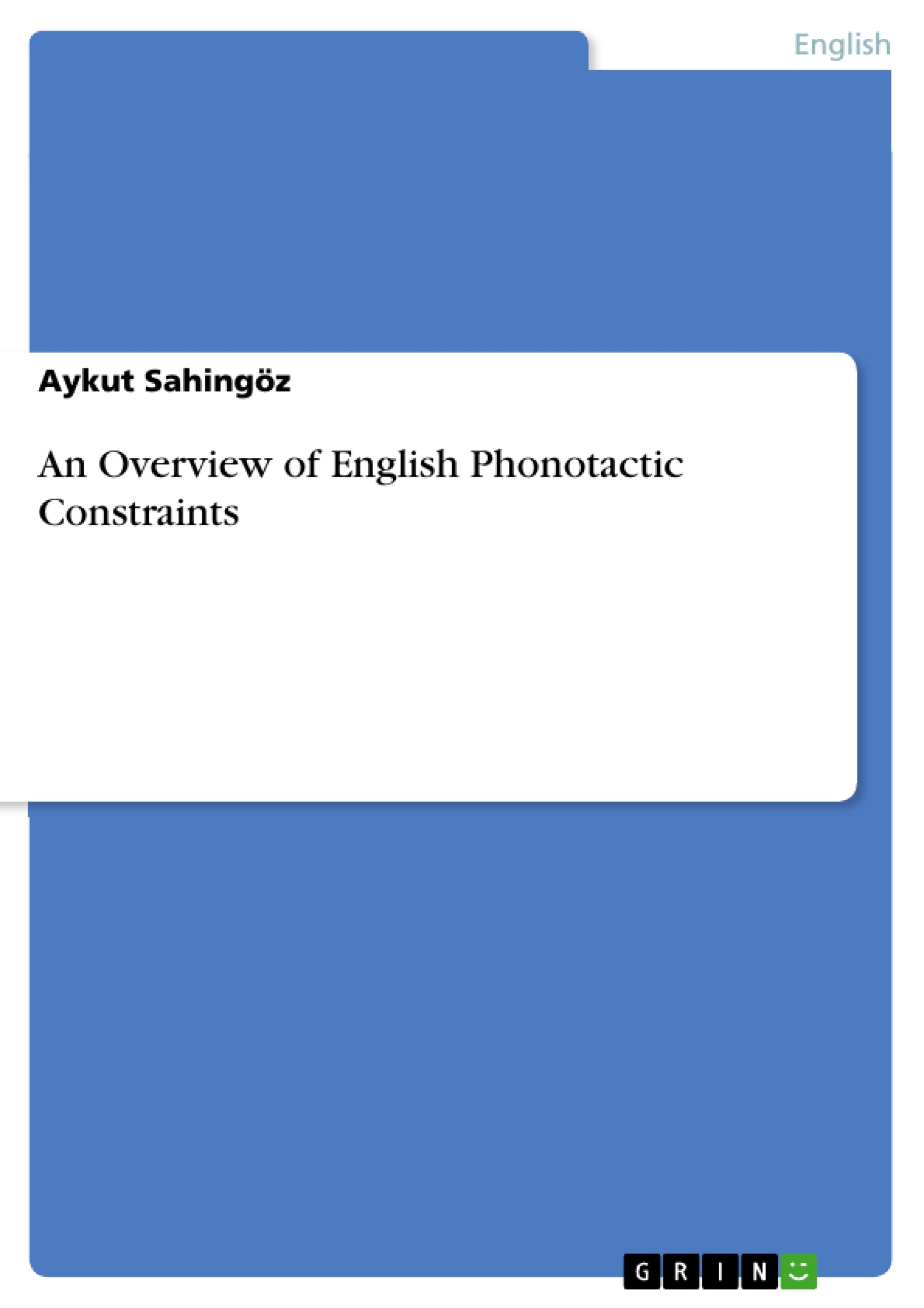This essay examines phonotactic constraints and how syllables are produced. Phonotactics resolve the question about how words are formed and if there are any rules for word and syllable creation. At first, the essay is going to explain the term of phonotactic constraints. The second topic is going to be about building of syllables, including the sonority sequencing principle. After that, English phonotactics will be compared with German and Turkish phonotactics. Finally, the maximum onset principle is to be explained, followed by a conclusion.
Table of Contents
- Introduction
- What are phonotactic constraints?
- How Languages build Syllables
- Phonotactic differences between languages
- Maximum Onset Principle
- Conclusion
Objectives and Key Themes
This essay aims to examine phonotactic constraints and syllable production in language. It explores how these constraints shape word formation and the rules governing syllable creation. The essay will also compare English phonotactics with those of German and Turkish.
- Phonotactic constraints and their role in syllable formation
- The Sonority Sequencing Principle and its application in syllable structure
- A comparative analysis of English, German, and Turkish phonotactics
- The Maximum Onset Principle and its implications
- The relationship between phonotactics, perception, and pronunciation.
Chapter Summaries
Introduction: This introductory section lays out the essay's objective: to investigate phonotactic constraints and syllable formation. It outlines the essay's structure, promising to define phonotactic constraints, explain syllable building (including the sonority sequencing principle), compare English phonotactics with those of German and Turkish, explain the maximum onset principle, and conclude with a summary of findings. The introduction establishes the scope and direction of the subsequent analysis.
What are phonotactic constraints?: This chapter defines phonotactics as a branch of phonology focusing on the permissible sound combinations within a language's syllable structure. It highlights that languages have specific rules restricting sound sequences, illustrating this with examples from English, such as the current prohibition of words beginning with /kn/, despite historical examples like "knot" and "knight." The chapter emphasizes that these constraints are not arbitrary but reflect systematic patterns in a language’s structure and are influenced by factors of perception and pronunciation.
How Languages build Syllables: This chapter introduces the concept of sonority—the relative loudness of a sound—as a key factor in syllable formation. It explains that syllable construction follows a sonority hierarchy, with the syllable nucleus (usually a vowel) representing the sonority peak. The chapter details the sonority hierarchy, differentiating between sonorants (vowels, glides, liquids) and obstruents (stops, fricatives), and explains how this hierarchy shapes the structure of onsets and codas. The "Sonority Sequencing Principle" is introduced, illustrating how sonority gradients structure syllables, using the example of "trump" to showcase the principle. The chapter also acknowledges an exception involving the consonant /s/ and its role in three-consonant clusters.
Keywords
Phonotactics, syllable structure, sonority sequencing principle, sonority hierarchy, consonant clusters, onset, nucleus, coda, phonological constraints, English phonology, comparative phonology.
Frequently Asked Questions: A Comprehensive Language Preview
What is the main topic of this language preview?
This preview focuses on phonotactics, specifically examining phonotactic constraints and their role in syllable formation across different languages. It explores the principles governing syllable structure and compares these principles in English, German, and Turkish.
What are the key themes explored in this preview?
Key themes include: the definition and role of phonotactic constraints in syllable formation; the Sonority Sequencing Principle and its application in syllable structure; a comparative analysis of English, German, and Turkish phonotactics; the Maximum Onset Principle and its implications; and the relationship between phonotactics, perception, and pronunciation.
What is covered in the "What are phonotactic constraints?" chapter?
This chapter defines phonotactics as the study of permissible sound combinations within a language's syllable structure. It illustrates how languages have specific rules restricting sound sequences, using examples from English and highlighting that these constraints are not arbitrary but reflect systematic patterns influenced by perception and pronunciation.
What is explained in the chapter about syllable construction?
The chapter "How Languages build Syllables" introduces the concept of sonority and the Sonority Sequencing Principle. It explains how syllable construction follows a sonority hierarchy, with the syllable nucleus (usually a vowel) representing the sonority peak. The hierarchy differentiates between sonorants and obstruents, showing how this shapes onsets and codas. The chapter uses examples to illustrate how sonority gradients structure syllables.
What languages are compared in this preview?
The preview provides a comparative analysis of English, German, and Turkish phonotactics, highlighting the differences in their syllable structures and phonotactic constraints.
What is the Maximum Onset Principle?
While the preview mentions the Maximum Onset Principle, a detailed explanation isn't provided in the summary. The preview indicates that this principle is discussed in a dedicated section of the full text.
What is the Sonority Sequencing Principle?
The Sonority Sequencing Principle explains how syllables are structured based on a sonority hierarchy. Sounds with higher sonority (like vowels) typically form the nucleus of a syllable, while sounds with lower sonority (like consonants) are found in the onset and coda, following a specific gradient of increasing and then decreasing sonority.
What are the key words associated with this preview?
Key words include: Phonotactics, syllable structure, sonority sequencing principle, sonority hierarchy, consonant clusters, onset, nucleus, coda, phonological constraints, English phonology, comparative phonology.
What is the overall objective of this preview?
The objective is to provide a comprehensive overview of phonotactic constraints and syllable formation in language, comparing and contrasting these principles across different languages. The preview serves as an introduction to the concepts and methodologies used in the full text.
Where can I find more detailed information?
This preview provides a summary of a larger work. The full text would offer a more in-depth exploration of the topics covered.
- Quote paper
- Aykut Sahingöz (Author), 2016, An Overview of English Phonotactic Constraints, Munich, GRIN Verlag, https://www.grin.com/document/538940




